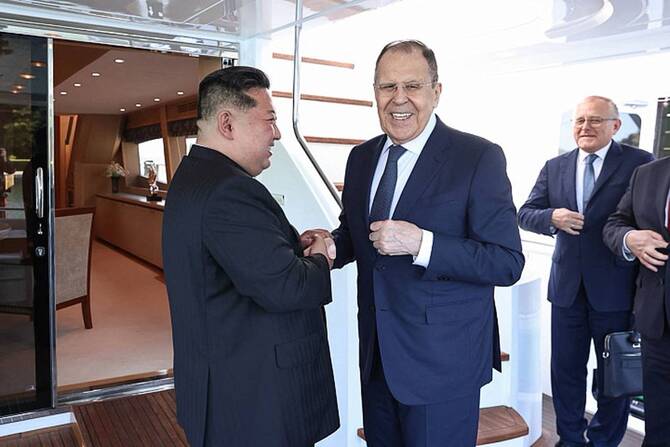Pahalgam, India: Indian security forces in Kashmir carried out a major manhunt Wednesday, a day after gunmen opened fire on tourists, slaughtering 26 people in the region's deadliest attack on civilians since 2000.
Prime Minister Narendra Modi, who cut short a state visit to Saudi Arabia, decried the "heinous act" and pledged that the attackers "will be brought to justice".
A hospital list of the dead verified by police listed 26 dead in the attack -- all men, who were killed on Tuesday afternoon when gunmen burst out of forests at a popular tourist spot and raked crowds of visitors with automatic gunfire.
All the dead were listed as residents of India -- many from across the country -- except one living in neighbouring Nepal.
Jammu and Kashmir Chief Minister Omar Abdullah said the attack had been "much larger than anything we've seen directed at civilians in recent years".
No group has claimed responsibility, but rebels in the Muslim-majority region have waged an insurgency since 1989.
They are seeking independence or a merger with Pakistan, which controls a smaller part of the Kashmir region and, like India, claims it in full.
"This attack on our visitors is an abomination," Abdullah said in a statement after the attack.
"The perpetrators of this attack are animals, inhuman and worthy of contempt."
AFP journalists near the site of the attack in Pahalgam, a popular site for tourists in summer some 90 kilometres (55 miles) by road from the key city of Srinagar, reported heavy deployment of security forces.
"The search operation is currently in progress, with all efforts focused on bringing the attackers to justice," the Indian army said in a statement.
In a separate incident, at Barumulla, the army reported Wednesday a "heavy exchange of fire" with gunmen they said were part of an "infiltration bid" crossing the contested frontier from Pakistan.
"Two terrorists have been eliminated", the army said.
At Pahalgam, a tour guide told AFP he reached the scene after hearing gunfire and had transported some of the wounded away on horseback.
Waheed, who gave only one name, said he saw several men lying dead on the ground, while a witness who requested anonymity said the attackers were "clearly sparing women".
The killings came a day after Modi met US Vice President JD Vance in New Delhi.
"Their evil agenda will never succeed. Our resolve to fight terrorism is unshakable and it will get even stronger," Modi said in a statement shortly after the attack.
The deadliest recent attack on civilians was in March 2000, when 36 Indians were killed. That attack occurred on the eve of a visit by US president Bill Clinton.
The killings on Tuesday sparked global outrage.
US President Donald Trump called Modi to quickly offer "full support to India to bring to justice the perpetrators of this heinous attack".
Among the foreign leaders condemning the attack and offering support, EU chief Ursula von der Leyen pledged that "Europe will stand with you".
India has an estimated 500,000 soldiers permanently deployed in the territory but fighting has eased since Modi's government revoked Kashmir's limited autonomy in 2019.
In recent years, the authorities have promoted the mountainous region as a holiday destination, both for skiing in winter, and to escape the sweltering summer heat elsewhere in India.
Around 3.5 million tourists visited Kashmir in 2024, mostly domestic visitors.
Air India said it was adding two extra flights out of Srinagar on Wednesday, as terrified tourists sought to return home.
The worst attack in recent years took place in Pulwama in February 2019, when insurgents rammed a car packed with explosives into a police convoy killing 40 and wounding at least 35 others.
Analyst Michael Kugelman argued that the attack posed a "very serious risk of a new crisis between India and Pakistan, and probably the most serious risk of a crisis since the brief military conflict that happened in 2019".
India regularly blames Pakistan for backing gunmen behind the insurgency.
Islamabad denies the allegation, saying it only supports Kashmir's struggle for self-determination.
One woman survivor described how men in uniform emerged from forests at a meadow where tourists were enjoying the peace of nature, The Indian Express newspaper reported.
Survivors said they had assumed they were policemen.
"They were there at least for 20 minutes, undeterred, moving around and opening fire", the newspaper quoted the survivor as saying.
"It seemed like an eternity".
India hunts gunmen who massacred 26 in Kashmir tourist hotspot
https://arab.news/w4e5n
India hunts gunmen who massacred 26 in Kashmir tourist hotspot

- Kashmir has been divided between nuclear-armed rivals India and Pakistan since their independence in 1947
- Rebel groups have fought for decades demanding independence for Kashmir or its merger with Pakistan


























